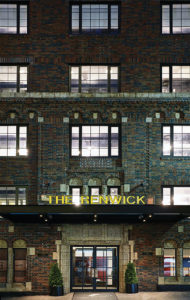NATIONAL REPORT—Reusing an old site to build a new hotel provides the latter with character, but staying authentic doesn’t come without additional costs and barriers.
“One of the great things about the adaptive-reuse of old buildings to create new hotels is how this often creates a unique property,” said Michael Tall, president and COO of Charleston, SC-based Charlestowne Hotels, a management company with a portfolio made up of at least 25% adaptive-reuse hotel properties. “In today’s paradigm of highly commoditized chain hotels, differentiating oneself as unique is a huge competitive advantage.”

A former residence to celebrated writers and artists, The Renwick Hotel New York City, Curio Collection by Hilton was one of the hospitality group’s general historic projects.
Adaptive-reuse doesn’t restrict a designer; it provides the framework for a designer to expand upon. “Adaptive-reuse offers a unique opportunity to be creative with an existing shell and design within an existing structure,” said Bill Wilhelm, president of R.D. Olson Construction, a national general contracting and construction management firm based out of Orange County, CA. “A designer can definitely get greater results and has a flexibility to be creative within that shell since most of the interior can be cleared out, and you are left with a very interesting juxtaposition of the original exterior and new interior.”
While these properties already provide stories for the designers and architects to share, they also create restrictions. For example, authenticity is imperative to success. “There are characteristics that an old structure will present, or that will unfold during the project, which can contribute to the design or even the operation of the hotel property,” Tall said. “One never knows what the final product may look like until the work is well underway.”
One common challenge when repurposing historic structures and landmarks is unforeseen obstacles arising from working at these sites. For instance, if artifacts are found, mandatory archeological exploration of the site can hold up projects from moving forward. “There may be projects where it’s not possible to analyze the forensics of the structure prior to work beginning, and so unpleasant surprises may be found, such as failing structural members, which must be reinforced—more often than not at great expense and some delay of the completion,” Tall explained.
Bringing historic sites up to code is another issue for developers. “Of course, updating the structure to current standards is of the utmost importance, but adaptive-reuse is still an attractive option because of its speed-to-market aspects,” Wilhelm pointed out.
“There are definitely cost considerations when building adaptive-reuse, particularly historic properties where preserving historic elements and working with local preservation societies is a priority,” said Matt Wehling, SVP of development in the U.S. and Canada at Hilton. “These initial investments may be offset by available tax deductions and other subsidies tied to the properties’ historic statuses, and the added allure that the historic properties hold for guests in competitive markets.”
Creating rooms in repurposed hotel properties presents obstacles for hoteliers as well, especially when room rates are being examined. “Unlike the typical chain hotel, there is no standardization of room shapes, sizes, features, etc., for the hotel within a repurposed building,” Charlestowne’s CEO said. “While we may have to develop descriptive content for only three or four room types for a new-build-flagged property, an adaptive-reuse project may require the creation of names and descriptions for a dozen unit types. The same attribute also complicates housekeeping since there is not a lot of standardization, requiring that we operate with a lot more attention to detail. The upside is that the attention to detail enhances the quality of the guest experience.”
A good reputation is valuable when searching for historic sites. Projects, more often than not, will be shared through word of mouth. “Our reputation for successfully launching and operating these types of properties keeps developers coming back to us,” Tall said. These developers are typically also in a hurry to hit the ground running for their ROI.
“The speed to market is key, so when developers want to get the most bang for their money in the shortest time frame, they often decide to go the way of adaptive-reuse,” Wilhelm explained. “There is even an added flexibility with floor layouts depending on the type of building that’s being repurposed. Once we go in there and clear the space and ready it for hotel rooms, there can be great flexibility with floor plan layouts.”

Current historic renovation and adaptive-reuse of the Old Bank of Italy building in downtown Los Angeles being restored by R.D. Olson Construction
There’s been an increase in repurposed hotels within the last five years, especially in secondary and tertiary cities, which can be attributed to the limited space available for new construction. “Adaptive-reuse has proven to be a great option for developers wanting to bring one of our brands to high-barrier-to-entry urban markets,” Wehling said. “Adapting old structures for new purposes is a great way to offer something special to our guests, while also conserving land, reducing urban sprawl and preserving the originality of historic buildings. In addition, buildings with a rich history and unique architecture offer an authentic experience for guests.” But developers and owners aren’t the only ones preferring adaptive-reuse hotel properties.
“The ones that we manage are consistently taking market share well above what would be regarded as fair market share,” Tall said. “We expect the number of repurposed hotel projects to double within the next five years. At Charlestowne alone, we have seen a large increase in adaptive-reuse projects within the pipeline of new hotel development—from independent to soft brands.”
For Hilton, location is often determined by brand need. “We want to develop properties in areas where there is a significant need for a particular brand, based on the local offerings and the travelers coming into that area,” Wehling pointed out. “The majority of Hilton’s current adaptive-reuse hotels are located in the U.S., but we have also completed adaptive-reuse projects in the U.K., Israel, Mexico, Russia, Netherlands, UAE, Argentina and Bolivia.”
“The current market is definitely busy and not quite yet oversaturated, but it is heading that way,” Wilhelm said. “We all wish we had that magic crystal ball to know exactly when this boom will slow, but the general trend says if you aren’t getting something started in the next 18-24 months, you may miss the peak of all of this new development. There is always going to be a need to improve existing areas and a good way to do that is through adaptive-reuse. Obviously, highly desirable geographic locations are going to be the most thriving for any of this type of work.” HB

